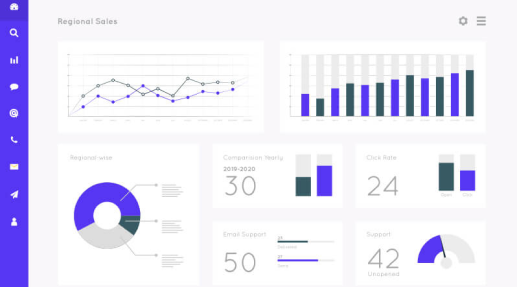Predictive Analytics
This service is highly valuable as it helps businesses forecast future trends, patterns, and outcomes based on historical data. It enables proactive decision-making, risk management, and strategic planning.
Data Visualization
This service is highly valuable as it helps businesses forecast future trends, patterns, and outcomes based on historical data. It enables proactive decision-making, risk management, and strategic planning.
Data Collection and Integration
This service is highly valuable as it helps businesses forecast future trends, patterns, and outcomes based on historical data. It enables proactive decision-making, risk management, and strategic planning.
Process For Cloud Solution
The process for implementing a cloud solution typically involves several key steps:
01
Assessment and Planning:
Evaluate your current IT infrastructure, applications, and data needs. Define your goals and objectives for migrating to the cloud. Identify the type of cloud deployment (public, private, hybrid) that best suits your requirements.
02
Selecting Cloud Service Providers:
Research and compare different cloud service providers based on factors like pricing, services offered, security measures, and compliance certifications. Choose the provider(s) that align with your budget and technical requirements.
03
Data Migration:
Assess and categorize your data based on its importance, sensitivity, and accessibility requirements. Plan and execute data migration strategies, such as lift-and-shift, re-platforming, or refactoring, to move your data to the cloud securely.
04
Application Migration or Development:
Evaluate your existing applications for cloud compatibility and determine the migration approach (rehost, replatform, refactor, rebuild, or replace). Develop new cloud-native applications or modify existing ones to leverage cloud services and capabilities effectively.
05
Infrastructure Provisioning and Configuration:
Set up cloud infrastructure components like virtual machines, storage, networking, and security configurations based on your workload requirements. Use Infrastructure as Code (IaC) tools like Terraform or AWS CloudFormation for automated provisioning and management.
06
Integration and Connectivity:
Establish connectivity between on-premises systems, cloud resources, and third-party services using APIs, VPNs, or direct connections. Integrate cloud services with existing IT systems for seamless data flow and interoperability.
07
Security and Compliance:
Implement robust security measures, including access controls, encryption, identity management, and threat detection, to protect your data and applications in the cloud. Ensure compliance with industry regulations and standards relevant to your business (e.g., GDPR, HIPAA, PCI DSS).
08
Performance Optimization:
Monitor and optimize the performance of your cloud resources using monitoring tools, performance tuning, and scalability options. Implement auto-scaling, load balancing, and caching mechanisms to handle fluctuating workloads efficiently.
09
Backup, Disaster Recovery, and Business Continuity:
Set up backup and recovery mechanisms to protect against data loss and ensure business continuity. Develop and test disaster recovery plans to recover quickly from unforeseen incidents or outages.
10
Training and Change Management:
Provide training and support for your IT team and end-users to familiarize them with cloud technologies and best practices. Implement change management processes to facilitate smooth transitions, address user concerns, and manage organizational change effectively.
11
Monitoring, Management, and Optimization:
Continuously monitor and manage your cloud environment using monitoring tools, alerts, and performance analytics. Optimize resource utilization, cost management, and scalability based on usage patterns and business needs.
Why Cloud Solution Is Important
There are some points to understand Why Cloud Solution Is Important :
Cloud solutions offer several important benefits that make them crucial for businesses and organizations:
Cloud Solution Frequently asked questions
-
01
What is a cloud solution?
A cloud solution refers to using cloud computing services to store, manage, and access data and applications over the internet instead of on local hardware or servers.
-
02
What are the different types of cloud deployments?
Cloud deployments can be categorized into three main types:
- Public Cloud: Services are provided by third-party providers and accessible over the public internet.
- Private Cloud: Services are dedicated to a single organization and can be hosted on-premises or by a third-party provider.
- Hybrid Cloud: Combines elements of public and private clouds, allowing data and applications to be shared between them.
-
03
What are the benefits of using cloud solutions?
Key benefits of cloud solutions include scalability, cost-effectiveness, flexibility, accessibility, reliability, security, and innovation capabilities.
-
04
How does cloud computing differ from traditional IT infrastructure?
Cloud computing replaces the need for physical servers and on-premises infrastructure by providing virtualized resources (e.g., servers, storage, databases) that can be accessed and managed remotely over the internet.
-
05
What security measures are in place for cloud solutions?
Cloud providers implement robust security measures such as data encryption, access controls, identity management, threat detection, and compliance certifications to protect data and applications hosted in the cloud.
-
06
How does data backup and recovery work in cloud solutions?
Cloud solutions offer built-in data backup and recovery mechanisms, allowing businesses to back up data regularly and recover it quickly in case of data loss, outages, or disasters.
-
07
Can cloud solutions integrate with existing IT systems?
Yes, cloud solutions can integrate with existing IT systems using APIs, connectors, and integration tools to ensure seamless data flow and interoperability.
-
08
How do I choose the right cloud provider for my business?
Consider factors such as pricing, services offered, scalability, security, compliance, reliability, customer support, and compatibility with your business requirements when choosing a cloud provider.
-
09
What is the cost structure for cloud solutions?
Cloud solutions typically follow a pay-as-you-go model, where businesses pay for the resources they use based on usage metrics such as storage, computing power, data transfer, and additional services.
-
09
How can I migrate to the cloud from traditional IT infrastructure?
Plan your migration strategy by assessing your current infrastructure, prioritizing workloads for migration, choosing the right cloud deployment model, implementing data migration strategies, and testing and optimizing the cloud environment post-migration.
To make requests for further information, contact us
-
Contact Number
+00(1) 123 456 7890
-
Our Mail
infotechmax@ourmail.com
-
Our Location
New ipsum dolor amet, eiusmod adipisicing 147 New Yors, NY Adipisicing 123

